-
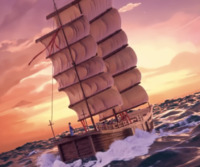
Dive is an animated film showing South Korea's rich history of folktales and inspiring Riew to draw upon "The Tale of Shimcheongjeon," also known as "Sim Cheong: The Dutiful Daughter." The main moral of this folktale is to highlight the filial piety, sacrifice, and redemption that Sim Cheong undergoes throughout her struggles to restore her blind father's sight. In doing so, she sells herself to sea merchants and learns that she must sacrifice herself to the sea. Impressed by her filial piety, the Dragon King, also known as the Sea King, returns her to the human world. In this act of self-sacrifice, Sim Cheong is reborn with truth and reunited with her father.
-
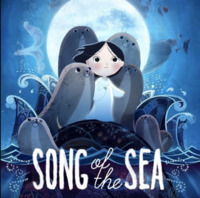
Song of the Sea is an animated film that explores the longing, searching, and complexities of love as Ben and his sister, Saoirse, are caught between different elements: the land and the sea. Throughout this song, the repetition of the phrase "Amhrán na farraige," also known as the Song of the Sea, emphasizes the symbolic significance that the sea holds. The sea is home to both tranquility and restlessness which is reflected in Ben's desire for a sense of peace and connection as he grapples with his relationship with his sister and acceptance of grief and loss.
-
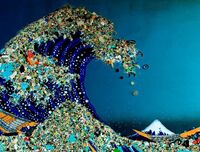
Exhibit by Bonnie Monteleone
She collected digital images of plastic artifacts retrieved from various garbage patches along with her own ocean photography to create the display.
-
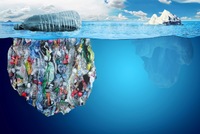
"In my opinion the issue about plastic and water is a really big problem to our health and environment.
about 8 million plastic items is being wasted, which could really effect and impact our health, the environment, the waterways etc. the more plastic pollution is being produced the more it could impact our lives. Most of the plastic that is being wasted is mainly effecting our waterways (oceans, lakes etc) and is harming our marine animals and important wild life elements in the water that could help the environment. These chemicals can accumulate in body tissues and have serious lethal effects on our immune system, and hormone balance. Floating plastic debris can produce ulcers, infections and lead to death. Marine plastic pollution can even reach birds that have never been at the sea. in conclusion Plastic causes pollution which is very dangerous to our environment and health."
-

A dumbo octopus in the Abyssal Zone. It is named for its large fins on either side of the top of its head that look like large ears resembling Dumbo the Elephant
-
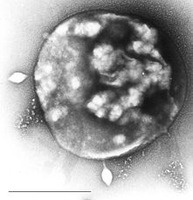
A Sufolobus, a microscopic single-celled chemotrophic producer in the Abyssal Zone
-
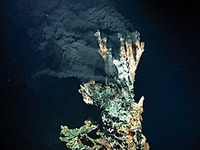
A black smoke hydrothermal vent emits sulfur for chemotrophs to produce energy.
-
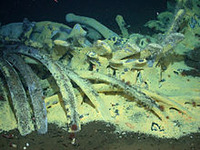
A whale carcass supporting an ecosystem in the Abyssal Zone
-
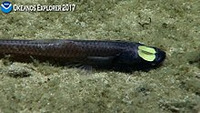
A Grideye Fish at the bottom of the seafloor in the Midnight Zone. The "eyes" of the fish are located at the top of its head where it senses changes in light rather than seeing directly
-

An angler fish in the Midnight Zone. Angler fish use a glowing lure-like pole from the top of their heads to bait in potential prey.
-
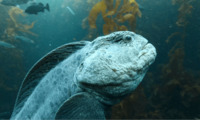
A large stone-like eel in the Twilight Zone. Many animals in the Twilight Zone take advantage of the inconsistent lighting and decreased brightness by camouflaging with their environment
-
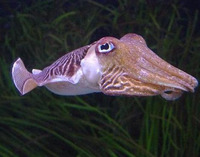
A cuttlefish, a relative of cephalopods like octopi and squid, swimming in the Twilight Zone.
-

A Fiddler Crab pictured in the Midnight Zone. Fiddler crabs have very uneven claw sizes
-
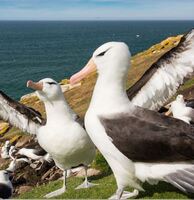
A couple of albatrosses which feed on high-dwelling marine life in the sunlight zone off of the ocean's surface
-

A five limbed starfish living in the Twilight Zone
-

A bioluminescent jellyfish is shown in an image taken during exploration of the Marianas Trench Marine National Monument area in the Pacific Ocean near Guam and Saipan,
-
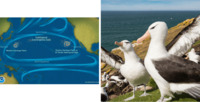
On left NOAA Pacific Island Garbage Patch Map and on right Albatross
-
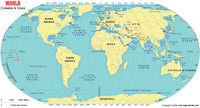
Map of the Oceans in the world
-
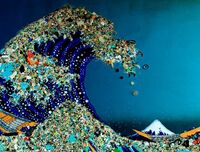
-
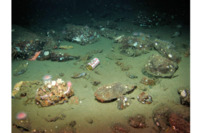
This images portrays the effects of pollution in the hadal zone. 4 billion microfibers per km² of plastic sink below the surface of the ocean and contaminate not just the hadal zone but the entire ocean ecosystem. The presence of waste in the hadal zone can harm hadal organisms which can prevent the recycling of nutrients back into the environment. In other words, human pollution can harm hadal organisms and thus the entire aquatic ecosystem.
-
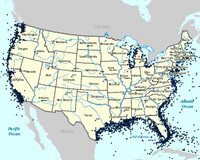
This digital map shows the distress calls received by all of the coats guard air stations in the US in 2000.
-
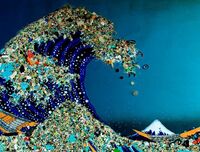
-
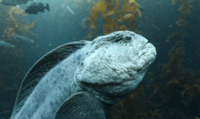
Wolf Eel
-

This installation work by Resa Blatman is made with layers that mimic oceanic life, such as the corals, seaweed, and flora. In addition, its projection out of the wall imitates that of violent waves. Her other works also address the issues of climate change on oceanic life through the use of plastic and other mediums.
-
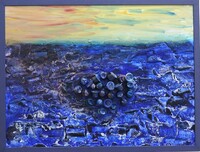
Painting by Gerhard Knolmayer
This piece is meant to represent the garbage currently floating in the Pacific Ocean. He uses small pieces in the center of the painting to depict the garbage patch
























